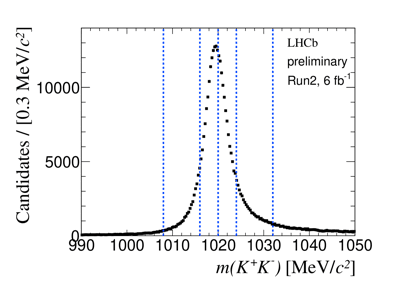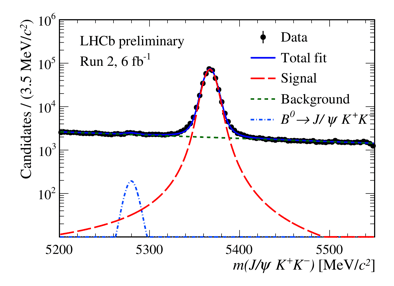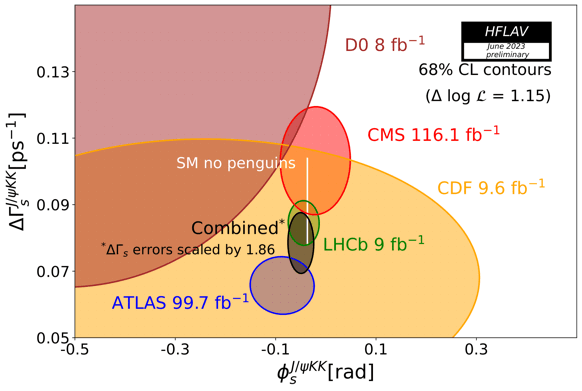Today at the CERN seminar the LHCb Collaboration presented the world’s best measurement of the CP-violating phase φs in Bs0 meson decays into J/ψK+K–. The phase φs plays a similar role in the Bs0 meson decays as the sin2β observable in the B0 decays whose precise measurement was also reported at the seminar.
In the wonderful world of quantum mechanics a Bs0 meson can decay directly or oscillate into a Bs0 meson and then decay. In analogy to the two-slit quantum mechanics experiment, these two modes of decay can interfere. Interference like this is one of the key ingredients for CP violation to occur. CP violation means that particles and their antiparticles behave differently when decay. It is required to explain why the universe we live in consists mainly of matter rather than antimatter. In this particular study, the CP violation would manifest itself as a nonzero value of the phase φs.
Within the Standard Model, the value of φs can be calculated precisely from other measurements. The predicted value of φs is small, about -0.037 rad, and New Physics effects, even if also small, could therefore change its value significantly.

In order to obtain this new result, LHCb physicists measured the decay-time-dependent CP asymmetry in approximately 349 000 Bs0→J/ψK+K– decays using the full Run 2 data sample collected at a centre-of-mass energy of 13TeV. The detailed study of the angular distribution of decay products was a special challenge in this analysis. The results supersede the previous analysis with partial Run 2 data and are combined with previous independent LHCb measurements including those obtained using Run 1 data. The new analysis benefits from improvements in calibration of the particle identification, flavour tagging algorithms, and the decay-time resolution model. The image above to the left shows the J/ψK+K– invariant mass distribution accumulated around the Bs0 meson mass. The mass of the K+K– meson pair system peaks around the φ meson mass as seen in the image above to the right.
The reported Run 2 value is φs = -0.039±0.022±0.006 rad. This is the most precise single measurement to date and it is consistent with the previous measurements and with expectations based on the Standard Model.
The phase φs is not the only interesting parameter that can be measured with Bs0-Bs0 oscillations. Following the rules of quantum mechanics, each of the particles can be expressed as a different combination of two quantum states that have slightly different masses and decay widths (and thus slightly different lifetimes). Their mass difference, Δms, determinates how fast Bs0 and Bs0 oscillate into each other. The difference of their decay widths, ΔΓs, was measured in this new analysis together with the value of φs and other parameters such as the difference between the Bs0 and B0 lifetimes (see seminar slides for numbers).
The image above shows the comparison of LHCb results in the plane φs-ΔΓs, with those from D0, CDF, ATLAS and CMS experiments located at hadron-hadron colliders, as well as the new world combination. The world φs combination gives the value φs = -0.039±0.016 rad. Note that the experiments at e+e– colliders, BaBar, BELLE and BELLE II, do not measure the φs phase.
The precision measurement of φs is one of the most important goals of the LHCb experiment. Over the past year’s the LHC has made the first high precision measurements of this quantity, including now this LHCb result using the full Run 1 and Run 2 data sample. In run 3 LHCb will collect a larger data sample taking advantage of the new upgraded LHCb detector, this will allow LHCb physicists to reach even higher precision in the future and, therefore, possibly to detect through this key quantity the manifestation of New Physics effects.
Read more in the LHCb presentation, in the CERN update in English and French as well as in the forthcoming paper.


